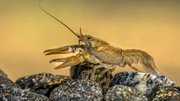
A ripple of muddy water, a flash of claws, and your prized water lily looks as if it’s been through a paper shredder. If you’ve spotted the tell-tale burrows or the midnight rustle of armored little tails, you’re not imagining things—crayfish have moved into your backyard oasis. Whether you call them crawdads, mudbugs, or freshwater lobsters, these industrious crustaceans can rearrange an entire pondscape in weeks. Before you panic (or reach for chemicals), here’s a clear-eyed look at why a pond crayfish invasion happens, how much damage it can do, and—most importantly—how to evict or coexist with them while keeping your fish, plants, and water quality in top form.
Introduction: Are Crayfish Good Or Bad For A Pond?
Crayfish are nature’s bulldozers. In the wild they recycle leaf litter, aerate silty bottoms, and feed everything from bass to herons. Drop that same behavior into an ornamental koi retreat, however, and the upsides shrink: tunneling undermines liners, uprooted plants cloud the water, and nocturnal hunting stresses fish already trying to dodge raccoons and egrets. The verdict? Crayfish in a pond can be both boon and bane—control is about balance, not total extermination.
How Do Crayfish Get Into Backyard Ponds?
- Stowaways in water-garden plants
- Eggs cling to the root balls of water hyacinth or lotus tubs. A single unnoticed clutch can populate a small pond by summer’s end.
- Hitchhikers in fish shipments
- Some suppliers raise koi, goldfish, or mosquito fish in outdoor raceways that already harbor crayfish. A juvenile can ride along hidden among oxygen plants.
- Upstream migrants
- During wet seasons, drainage ditches and seasonal creeks become crayfish highways. If your liner overflows or you pump fresh creek water in, expect uninvited guests.
- Curiosity releases
- Kids sometimes “rescue” bait-shop crustaceans and let them go after a fishing trip. Two introduced adults can lay hundreds of eggs.

Signs Of Crayfish In The Pond
Cone-shaped chimneys of mud near the waterline, missing lily pads, and jagged holes in marginal plant baskets are classic giveaways. At dusk, shine a flashlight along the edges—amber eyes glow back. Fish acting skittish after dark or unexplained pinches on fins point to prowling crustaceans. Sediment clouds that return hours after a partial vacuum also hint at overnight digging.
Do Crayfish Harm Pond Ecosystems?
Plant Destruction – They clip stems to drag into burrows for food. Tender oxygenators such as hornwort are shredded first.
Water Turbidity – Silt from tunnels hangs in suspension, turning clarity into a crayfish in ponds milkshake.
Predation – Larger species ambush slow fancy goldfish, snails, and even tadpoles.
Structural Damage – Persistent burrowing beneath liners or concrete shelves can create leaks or collapses.
That said, moderate numbers can benefit wildlife ponds by recycling detritus and controlling mosquito larvae. The tipping point is usually when visual appeal, plant health, or fish safety starts falling off.

How To Remove Or Control Crayfish
Manual Trapping
- Baited burlap bags* or mesh traps loaded with shrimp pellets work overnight. Empty at dawn before fish investigate.
- Hand netting* at dusk with a headlamp snags surface cruisers. Ten minutes a night can dent the population in a small water feature.
Reduce Breeding Sites
Shallow, still warm pockets are crayfish nurseries. Fill redundant shelves with clean gravel, raise pump pickups, and keep circulation brisk. A Poposoap Pond Aerator or a compact solar fountain keeps water moving where power cords can’t reach.
Predator Support
Healthy koi—or even sturdy goldfish—will snack on juvenile crayfish. Provide hiding tubes for fish so the hunter doesn’t become prey during molt cycles.
Nutrient Control
Crayfish thrive on excess algae and leaf litter. Installing a Poposoap Pond Filter with layered foams, bio-media, and an optional UV clarifier strips suspended organics before they settle into a free buffet.
Barriers & Trench Traps
A smooth plastic edging at the waterline reflects climbing claws, while a perimeter trench with steep sides catches wanderers before they reach beds or lawn.
If your goal is total removal—say you maintain prize waterlilies—continue trapping weekly for two full life cycles (roughly one season) and stay vigilant each spring.
Can You Coexist With Crayfish In A Pond?
Yes, if you adopt a managed coexistence mind-set:
- Limit Numbers – A casual target is one crayfish per 100 gallons. Beyond that, plant loss accelerates.
- Choose Tough Flora – Pickerel rush, dwarf cattail, and water iris survive occasional pruning better than fine-leaf anacharis.
- Provide Decoy Food – Sinking algae wafers divert feeding from live lilies.
- Segment the Habitat – Use stone terracing or floating planters. Crayfish prefer edges; elevated baskets keep delicate rhizomes above pinch height.
- Maintain Redundant Filtration – Even a small stock of mudbugs stirs sludge. Pair your main waterfall pump with a Poposoap Floating Fountain so suspended fines settle less.
If you run a wildlife pond with frogs, dragonflies, and little interest in manicured aquascaping, the occasional crayfish might simply be another link in your food web.
Conclusion: Crayfish = Risk + Reward
Do crayfish live in ponds? Absolutely—and they will thrive in yours if conditions allow. Their arrival signals healthy, fish-safe water but also sets up a contest between natural behavior and ornamental goals. The key is informed action: remove excess individuals, fortify filtration with Poposoap’s solar-powered aerators and filter boxes, and design plant zones that meet both aesthetic and ecological needs. Done right, you can enjoy the occasional glimpse of a clawed gardener scuttling under moonlit Poposoap Pond Lights without sacrificing the graceful sweep of lotus leaves or the glass-clear water every pond keeper dreams about.








